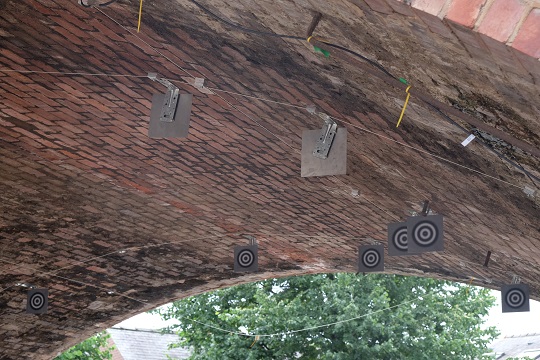Submitted by Dee Dee Frawley on Wed, 07/12/2016 - 16:21
CSIC’s deployment of fibre optic sensing to monitor masonry arch bridges has provided new insights into the behaviour of this type of structure and could provide a simple and affordable method to identify structural damage.

Image: An arch instrumented with FBG cables and photogrammetry targets in the Marsh Lane Viaduct, Leeds
Working with Industry Partner Network Rail, CSIC has been monitoring an operational Victorian viaduct in Leeds for the past 14 months. The objective is to better understand the dynamic response of the viaduct to rail traffic and identify the mechanisms that drive its degradation, to inform maintenance and long-term management. The viaduct is one of around 40,0001 masonry arch bridges that form an integral part of the UK’s road, rail and waterway infrastructure.
The dynamic response, measured while trains pass over the viaduct, was monitored on two adjacent spans of the viaduct using a Fibre Bragg Grating (FBG) sensing system. To our knowledge, this marked the first deployment of FBG sensors in a masonry viaduct worldwide. Evaluation of the resulting fibre strain data was made possible with a novel non-contact videogrammetry solution, provided by video-based, non-contact precision measurement specialists, Imetrum. The results demonstrated excellent agreement and highlighted the ability of fibre optic cables to detect very small strains to illustrate the flow of forces inside the structure.
Dr Sinan Acikgoz, Research Associate at CSIC, said: “The fibre optic sensing has provided a new understanding of how arches in the viaduct interact during dynamic rail loading. In particular, we found that the rotation of the piers caused an opening in the span, and this action controlled the how the arch responded to the dynamic loading. We were also able to identify the critical sections of the structure which experience tensile forces, where damage is likely to concentrate in the future”.
In addition, lasers scanners were used to create a 3-D model of the underside of the arch to measure how the structure has deformed over time. The analysis of the deformed geometry from these models has enabled CSIC researchers to quantify the critical movements experienced by the structure in the past. An understanding of these movements has also helped develop a better understanding of the dynamic response of the viaduct to rail loads as it is also influenced by this existing damage.
“Through this work we now have a better understanding of the structural response of masonry viaducts. The sensing data has allowed us to explain existing damage, to identify critical aspects of the structural response, and to better evaluate the effectiveness of potential intervention techniques”, said Dr Matthew DeJong, CSIC Project Leader.
CSIC researchers are now aiming to apply the understanding of the response of this particular bridge to other similar viaducts. New assessment techniques are being formulated and measurements in similar viaducts are being recorded for this purpose. CSIC researchers also plan to explore critical engineering issues including the influence of increasing train speed and the angle of bridge skew on the dynamic response of arch bridges.
“Based on improved understanding, we hope to optimise instrumentation and monitoring techniques that will allow us to efficiently identify structural damage and improve maintenance”, said Matthew.
1 Masonry arch bridges: condition appraisal and remedial treatment McKibbins, L; Melbourne, C; Sawar, N; Sicilia Gaillard, C. CIRIA
Related Links
Assessing Victorian masonry arch bridges for asset management
